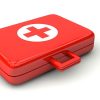Magnet Safety and First-Aid Assistance
If you’re in an industry that utilizes magnets to improve operations, you have likely experienced the painful pinch of a finger stuck between two magnets. However, there are other potential dangers apart from cuts and blisters. Injuries can range from minor damage to something more significant like a broken bone or bad burn.
Regardless of whether your role is hands-on or more managerial, you should be ready for the worst-case scenario. This preparedness begins with a firm understanding of the danger magnets can present and – perhaps most important – proper first aid techniques.
What to Know About Neodymium Magnets
As it pertains to magnetic strength, neodymium magnets are considered among the most powerful in the world. In certain situations, they can even break bones. A neodymium magnet is made up of magnetic material containing an alloy combined with neodymium, iron, and boron to form its structure, which places it under the umbrella of “rare-earth magnets.” If two magnets are swallowed, their magnetic force is strong enough to attach to one another through the walls of the intestines, causing tears or even stopping blood flow. Neodymium can also affect heart pacemakers, implantable cardioverter-defibrillators (ICD), and other medically implanted devices. If possible, make sure to deactivate such devices when in the presence of powerful magnets, or avoid them entirely. Avoid drilling into neodymium magnets as well. When ground into a dust or powder, their remnants are highly flammable and – if there’s enough – can easily torch an entire room.Common Injuries and First-Aid Techniques
1: Pinching When you pinch your skin between two magnets, you typically form a blood blister.- Do not touch or pick the blister.
- Keep the blister covered; allow it to dry out over a period of days or weeks.
- Contact a doctor if it needs to be drained.
- Seek further medical help if there are signs of infection.
- Remove whatever caused the initial burn.
- “Stop, drop, and roll,” if necessary.
- Remove clothing or material from around the burn; cut away tight clothing or jewelry.
- Identify the type of burn: 1st, 2nd, or 3rd.
- If the burn has penetrated all layers of the skin, call 911.
- If you’re dealing with a 1st degree burn, place it in cool water; cover the burn.
- Seek further medical help if there are signs of infection.
- Immobilize the affected area immediately; stay as still as possible.
- Apply ice to the area around the broken bone to prevent swelling.
- Call 911 or receive transportation to the hospital.
- Seek medical help immediately; call poison control and/or go to the hospital.
- Check the entire body for cuts or wounds.
- If a cut is identified, wash with cold water to loosen up the skin.
- Gently remove any blood with either an antiseptic wipe or a soft cloth and hydrogen peroxide.
- Apply light pressure to remove any debris from inside the cut.
- Cover the cut with gauze and a band aid to avoid infection.
- Seek further medical help if there are signs of infection.
- After contact, apply lotion or medicinal lubricant to the affected area. A doctor can prescribe either Corticosteroid or Nonsteroidal cream.
- Apply a wet compress to relieve itching; allow any blisters to dry out.
- Moisturize regularly with mineral oil or petroleum jelly to aid in the recovery process.
- Seek further medical help if there are signs of infection.

